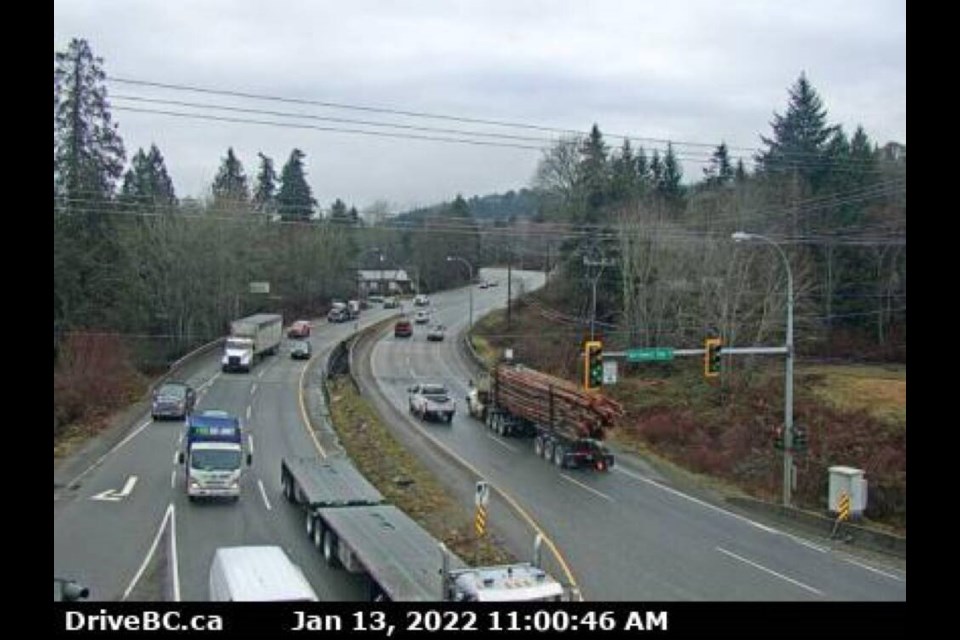Until the weather warms up enough to enable crews to repave a section of Highway 19 that has recently become a minefield of potholes, any solution is likely to be temporary, the company contracted to maintain the stretch has warned.
The problem is affecting northbound motorists travelling in the right lane between Lantzville Road and Northwest Bay Road.
As of Wednesday, ICBC had received 163 claims from motorists whose vehicles suffered varying degrees of damage to wheels and tires after hitting the potholes.
Teagan Burton, operations manager for Mainroad Mid-Island Contracting, the company responsible for highway maintenance for the section, said the problem is the weather.
“The fluctuating temperatures we have been experiencing is the perfect recipe for potholes to appear and worsen,” Burton said. “Our crews have been out patching some potholes two to three times in a 12-hour period.”
Potholes are the result of melting snow and water re-freezing. The freeze-thaw cycle causes expansion and contraction of the asphalt during the winter months. When water enters a crack in the pavement then freezes, the asphalt expands. The constant fluctuation of expansion and contraction weakens the asphalt, causing potholes to form.
Due to colder winter temperatures, crews can only fill the potholes with “cold patching,” using a specially formulated asphalt mixture. The formula is used because it is more flexible for use in low temperatures.
But the ideal condition for application is for the temperature to be over 10 C and the ground to be dry.
“When we apply to a wet and cold surface, it won’t cure properly and the next freeze-thaw cycle will push the patches out,” said Burton.
The situation is exacerbated because the potholes are in the right lane, which sees the lion’s share of heavy truck traffic.
“It’s like a game of Whac-A-Mole — as soon as they patch one hole, another appears,” said James McNulty, owner-operator of Five Star Paving, who said he feels for what the patching crews are going through.
“At cold temperatures, asphalt doesn’t bond, and because the cold patch is always pliable, it gets pushed out as soon as a heavy load goes over it. We generally suspend paving over the winter and, even if we did, we likely would end up having to re-do it once the weather gets warmer.”
There is a “hot patch” solution, but to be effective, it requires material sourced from a hot asphalt plant — usually closed between Christmas until the end of January — to be applied during a stretch of warmer, drier weather.
“Don’t forget that even if the daytime high hits 10 degrees, it’s only that for an hour or two,” said McNulty, who has 16 years of experience in the industry. “It’s just not enough time to do a good, long-lasting job.”
According to ICBC, pothole claims are covered under a vehicle’s optional collision coverage, available from either ICBC or another insurance company.
A collision claim could affect a customer’s insurance premium, with the financial impact varying from driver to driver based on how long they’ve been driving and how many chargeable claims they’ve made. Drivers with a long record with no chargeable claims may be eligible for claim forgiveness so the claim would not affect their premiums.
If negligence can be proven against the party responsible for road maintenance — for instance, there was an unreasonable delay in taking action after the pothole was reported — ICBC may seek to recover the cost of the claim.
Alternately, drivers can claim compensation through the Ministry of Transportation and Infrastructure, which has contracts with highway maintenance contractors that require the contractor to meet certain standards and response times. Once a deficiency, such as a pothole, has been detected, the contractor must make the necessary repairs within a certain period.
To make a successful claim, a motorist would have to provide proof that there was negligence on the part of the ministry or highways contractor.
On Thursday, Adam Walker, MLA for Parksville-Qualicum, issued a statement saying he’s raised the issue with the Transportation Ministry, and offering to help affected motorists.
“I am aware of the rough road conditions along Highway 19, having seen them myself and have heard from people who have had damage to their vehicle,” he said. “This is a serious issue, given that this road is the primary connection between north and south Vancouver Island.
“My office is here to help connect people who have been affected by the potholes with resources and help with questions about claims processes or other related topics.”

